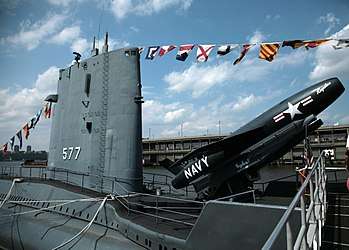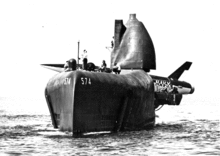USS Growler (SSG-577)
 Regulus I missile aboard USS Growler at Pier 86 in New York, its museum ship home. | |
| History | |
|---|---|
| Name: | Growler |
| Namesake: | Growler, Fish |
| Ordered: | 31 July 1954 |
| Builder: | Portsmouth Naval Shipyard |
| Laid down: | 15 February 1955 |
| Launched: | 15 April 1958 |
| Sponsored by: | Mrs. Robert K. Byerts, widow of Commander Thomas B. Oakley, Jr. |
| Commissioned: | 30 August 1958 |
| Decommissioned: | 25 May 1964 |
| Struck: | 1 August 1980 |
| Status: | Museum ship at the Intrepid Sea, Air & Space Museum |
| Badge: |
 |
| General characteristics USS Growler SSG-557 | |
| Class and type: | Grayback class submarine |
| Displacement: | 2,110 tons light, 3,550 tons full, 1,440 tons dead |
| Length: | 96.9 m (318 ft) overall, 96.3 m (316 ft) waterline |
| Beam: | 8.2 m (27 ft) extreme, 7.9 m (26 ft) waterline |
| Draught: | 5.7 m (19 ft) |
| Propulsion: | 3 Fairbanks-Morse Diesel engines, 2 Elliott electric motors |
| Speed: | 15 kn (17 mph; 28 km/h) surfaced, 12 kn (14 mph; 22 km/h) submerged |
| Complement: | 9 officers, 78 men |
| Armament: |
|
The USS Growler (SSG-577) was an early attempt by the U.S. Navy to field a cruise missile submarine which would provide a nuclear deterrent using its second series of cruise missiles. Built to deliver the Regulus I cruise missile, an extension and adaptation of the German V-1 vengeance weapons technologies.
The Growler was the second and final submarine of the Grayback class, it was the fourth ship of the United States Navy to be named after the growler type of largemouth bass—the practice in the day to name submarines after carnivorous fish. Since Regulus I, and Regulus II programs had their problems, Growler and Grayback were the only two submarines built in this class as instead, the U.S. Navy veered its nuclear deterrence efforts into submarine launched ballistic missiles (SLBMs)—the Polaris missile program.
What makes Growler and her sister unusual was her nuclear armament, deployed on a conventional (non-nuclear powered) diesel-electric submarine. Her mission was to provide nuclear deterrent capability off the Pacific Coast of the Soviet Union during peak years of the Cold War, from 1958 to 1964.
Construction and training

Growler was laid down on 15 February 1955 by the Portsmouth Naval Shipyard of Kittery, Maine. She was launched on 5 April 1958 sponsored by Mrs. Robert K. Byerts, widow of Commander Thomas B. Oakley, Jr., who commanded the third Growler on her 9th, 10th, and fatal 11th war patrols. Growler commissioned at Portsmouth on 30 August 1958 with Lieutenant Commander Charles Priest, Jr., in command.

After training exercises off the East Coast Growler sailed south for her shakedown cruise, arriving at the Roosevelt Roads Naval Station, Puerto Rico, on 19 February 1959. After a brief run back to Portsmouth, she returned to the Caribbean Sea in March to train in launching Regulus I and Regulus II nuclear cruise missiles, assisted by USS Runner, which was one of several submarines with Regulus guidance equipment. Growler returned to Portsmouth 19 April via Fort Lauderdale, Florida, and New London, Connecticut.
Operational history
Growler then proceeded to the Pacific via Norfolk, Virginia, Key West, Florida, and the Panama Canal, putting in at Pearl Harbor on 7 September to serve as flagship of Submarine Division 12. At Pearl Harbor the guided missile sub participated in a variety of battle and torpedo exercises as well as missile practice before beginning her first Regulus Deterrent Mission. On this mission, which lasted from 12 March to 17 May 1960, Growler departed Hawaii with a full store of Regulus sea-to-surface missiles, armed with nuclear warheads, and patrolled under a strict cloak of secrecy. Their patrols could last two months or more at a stretch and required them to remain submerged for hours and even days—which pales in comparison to the patrols of nuclear-powered ballistic missile submarines, but was a strain for the crew of a much smaller diesel boat. It is traditional that the log entries for 00:00 (midnight) on New Year's Day be made in verse. On 1 January 1961, during Growler's second patrol, Lieutenant (j.g.) Bruce Felt wrote: "Not our idea of fun and good cheers/But doing our job to ensure many New Years."
According to the documentary "Regulus: The First Nuclear Missile Submarines" the primary target for Growler in the event of a nuclear exchange would be to eliminate the Soviet naval base at Petropavlovsk-Kamchatsky.[1] The patrols made by Growler and her sister Regulus-firing submarines represented the first ever deterrent patrols in the history of the submarine Navy, preceding those made by the Polaris missile firing submarines.[1]
From May 1960 through December 1963 Growler had made nine such deterrent mission patrols, one of which, the fourth, terminated at Yokosuka, Japan, on 24 April 1962, as the Navy displayed one of its newest weapons.
Decommissioning and fate
Returning to Mare Island, California, Growler decommissioned 25 May 1964 and was placed in reserve. She was initially moved to the Inactive Fleet section in the Puget Sound Naval Shipyard in Bremerton, Washington and was later relocated to the Philadelphia Naval Shipyard. She was struck from the Naval Vessel Register on 1 August 1980 and was scheduled to be used as a torpedo target. However, on 8 August 1988, Congress awarded the hulk to Zachary Fisher, Chairman of the Intrepid Sea, Air & Space Museum in New York City.
Due to the renovations to the entire Intrepid Sea, Air & Space Museum complex, including USS Intrepid and Pier 86 the Growler was towed to Brooklyn for repairs. Holes found rusted in the hull complicated matters and pushed repair costs past $1.5 million. The Growler returned to Pier 86 in late February 2009, and was re-opened to the public on 21 May 2009, during the Intrepid museum "Fleet Week 2009" celebration.
References
This article incorporates text from the public domain Dictionary of American Naval Fighting Ships. The entry can be found here.
- Gardiner, Robert. Conway's All the World's Fighting Ships 1947–1995, London: Conway Maritime Press, Ltd, 1995, pp. 609–610
External links
| Wikimedia Commons has media related to USS Growler (SSG-577). |
- USS Growler (SSG-577) at Historic Naval Ships Association
Coordinates: 40°45′54″N 74°00′00″W / 40.765110°N 73.999990°W